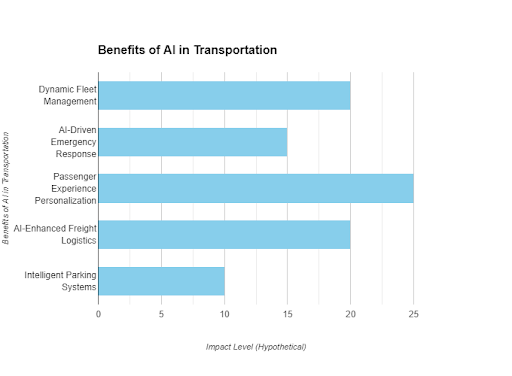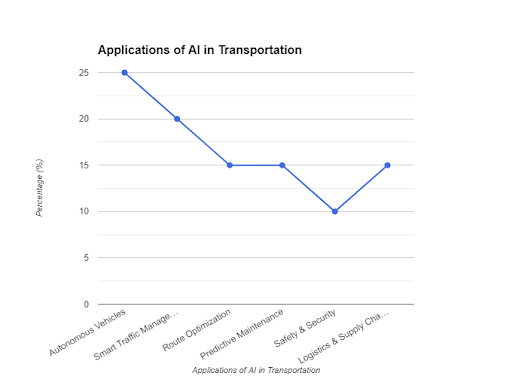Introduction
Artificial intelligence (AI) is changing the transportation industry by making it more efficient, safer, and environmentally friendly. Using technologies like machine learning and the Internet of Things (IoT), AI makes it convenient for people to travel and manage transportation systems in their hectic routines.
Consider the innovation of self-driving cars, which KPMG predicts will reach about 800,000 units worldwide by 2030 and could reduce accidents by up to 90%. AI also assists with traffic management. It analyzes real-time data and comprehends the difficulties that occur in transportation, making it easier for people to move around cities.
In logistics, companies like UPS use AI to plan better delivery routes, saving over 10 million gallons of fuel each year. This highlights the growing need for smarter transportation, and AI is leading the way to safer and more productive ways to travel and transport goods.
Let’s examine the current market landscape, the prospects of AI in transportation, and whether investing in this technology is a smart choice.
How AI Improves Transportation System
First off, these technologies help us manage traffic better.
AI already predicts how traffic will flow, which allows for smarter routing and congestion control—making cars move more smoothly on roads and also reducing those frustrating delays we all hate.
But it’s not just about cars. AI and ML also improve scheduling for planes and trains, making sure they run on time and are well-maintained. That’s a win for travelers!
Another big perk is how AI helps with energy efficiency. By analyzing data from various sources, AI transportation systems facilitate cities saving energy and shrinking operational costs. Which elevates the overall quality of life for everyone living in the city.
AI is set to play an even bigger role in optimizing complex transportation networks, all while promoting sustainable growth for our urban areas.
A notable tweet by Daniel Wong (AI and Transportation Specialist) on AI’s impact on transportation states
“AI in public transport is transforming cities by improving traffic management, enhancing safety, and reducing emissions.” </strong >
This represents how AI is making public transport more reliable and sustainable.
Implementing AI in Transportation: Key Challenges and Effective Solution
AI and ML are redefining how we move around in cities, making travel safer, more efficient, and better for the environment. But it’s not easy to implement; several key challenges that occur when implementing AI are listed below:
Challenge 1: Data Privacy and Security
AI used in transportation has to deal with the collection of vast amounts of sensitive data related to passenger information, travel routes, and vehicle performance, which raises concerns over data privacy and security.
Solution: The implementation of robust encryption techniques and secure storage systems has resolved this privacy concern and protected data from cyber threats. Adhering to regulations like the General Data Protection Regulation (GDPR) guarantees that data handling is compliant with privacy standards, building public trust in AI systems.
Challenge 2: Integration with Existing Infrastructure
Many cities have older transportation systems that need more infrastructure to support AI technologies. Retrofitting these systems for AI can be costly and complex.
Solution: Gradual upgrades through pilot programs help integrate AI without disrupting current services. Cities now have this opportunity to implement AI solutions in phases, testing them in controlled environments before full-scale deployment, which allows for frictionless interfaces with legacy systems.
Challenge 3: High implementation costs
The initial investment required for AI technology, including software, hardware, and skilled labor, creates a barrier for cities and transportation agencies.
Solution</strong >: Focusing on the long-term benefits of AI, such as reduced operational costs, improved traffic flow, and energy efficiency, can make the investment worthwhile. Hence, you don’t have to fix every issue in transportation all the time; public-private partnerships and government grants can help offset initial costs, making it more feasible for cities to adopt AI.
Challenge 4: Public Trust and Acceptance
People are often hesitant to trust AI technologies in transportation, especially with autonomous vehicles, due to concerns over safety and control.
Solution</strong >: Public education campaigns that highlight the safety measures and reliability of AI systems can help build trust. Real-world demonstrations and transparent communication about AI benefits can also ease concerns, encouraging wider adoption.
Challenge 5: Ethical Concerns and Algorithmic Bias
AI systems can sometimes exhibit biases in decision-making, such as prioritizing certain routes or areas over others, leading to unequal access to services.
Solution: To combat this, AI algorithms should be developed with diverse datasets that reflect the needs of all users. Further, AI systems must follow ethical guidelines to ensure fair and equal treatment for all, avoiding biases in transportation services.

Benefits of AI in Transportation
AI used in transportation manages traffic flow by adjusting signals based on real-time data. It speculates with route planning, vehicle maintenance, and safety hazard detection. Let’s see some more benefits.
1. Dynamic Fleet Management:
AI has been great in managing fleets because of its real-time tracking of cars, forecasting demand, and adjusting routes. This helps to allocate parking spaces so people don’t have to wait long enough, plus it also gives us fewer empty trips and higher vehicle utilization, lowering operational costs and decreasing the environmental impact that makes life easier and manageable.
2. AI-Driven Emergency Response:
AI systems have shown great potential in emergency response and quick availability of emergency vehicles. In critical situations such as accidents or natural disasters, AI can also reroute traffic to clear paths for ambulances and fire trucks, reducing response times and potentially saving lives.
3. Passenger Experience Personalization
AI-powered transportation promotes the best passenger experience as well, by recommending the best travel options based on user preferences and real-time conditions. It doesn’t matter if it requires selecting the fastest route, suggesting alternative modes of transport, or adjusting for accessibility needs; AI helps provide a more tailored and convenient journey.
4. AI-Enhanced Freight Logistics
AI’s best perk is to identify weather patterns, traffic conditions, and fuel efficiency before letting freight transport by optimizing logistics, route planning, and load management. It helps freight companies minimize costs and delays while also improving delivery accuracy and sustainability.
5. Intelligent Parking Systems
AI is rebuilding the parking experience by providing real-time information on available parking spaces and predicting future availability. These intelligent systems reduce the time spent searching for parking, easing congestion in busy urban areas and cutting down fuel consumption associated with circling for a spot.

Application of AI in Transportation
Artificial intelligence (AI) is being applied innovatively within the transportation sector, significantly enhancing the user experience. Here are five prominent applications of AI in transportation:
1. Intelligent Traffic Management Systems
AI traffic systems use real-time data from sensors and cameras to improve traffic flow. They can automatically change traffic light timings and reroute vehicles based on current conditions. Cities like Taichung and Vienna use similar methods to prevent congestion, making commutes easier for everyone.
2. Autonomous Vehicles
Self-driving cars are a major advancement in transportation. These vehicles use sensors and AI to navigate without a driver. They can analyze their surroundings and make decisions in real-time, aiming to improve safety and efficiency. Companies like Waymo and Tesla are leading in this technology to reduce accidents.
3. Predictive Maintenance
AI has changed how we take care of cars and infrastructure. It can predict when parts might fail by analyzing data from car sensors and maintenance history. This means repairs can be made before problems occur, which saves time and costs while keeping vehicles safe to use.
4. Upgrade Public Transportation Systems
AI improves public transport by adjusting routes and schedules based on how many passengers are using the service. Transit systems can add more buses or trains during busy times by watching ticket sales and counting passengers, making public transportation better and more pleasant for everyone.
5. Smart Logistics and Supply Chain Management
In logistics, AI helps optimize delivery routes and manage fleet performance. It looks at traffic patterns and weather to find the best routes for deliveries. This reduces fuel use and speeds up delivery times, benefiting companies like UPS and FedEx that depend on timely logistics.

Top Use Cases of AI in Transportation
1. Waymo’s Self-Driving Taxis
Waymo, a company under Alphabet, is leading the way in self-driving cars. Waymo runs fully autonomous taxis in Phoenix, Arizona that operate without human drivers. These cars use AI to process data from cameras, sensors, and radar in real time. Waymo’s AI learns from each ride to improve safety and efficiency, and to make city transport safer and more convenient through driverless rides.
2. Tesla’s Autopilot for Semi-Autonomous Driving
Tesla uses AI in its cars through the Autopilot feature, allowing semi-autonomous driving. The AI uses data from sensors to help the car steer, speed up, and brake on its own. With regular software updates, Tesla’s AI improves over time, enabling features like lane-changing and self-parking. It also boosts safety by predicting potential dangers and helping prevent accidents. Tesla’s AI has expanded what’s possible in automated driving.
3. Uber’s AI for Dynamic Pricing and Route Optimization
Uber uses AI to make its ride-hailing services more efficient. One key use is dynamic pricing, where AI adjusts ride prices based on demand and traffic conditions. Uber also uses AI to find the fastest routes for drivers and reduce waiting time. By analyzing traffic and rider patterns, Uber ensures quicker pickups and smoother service. AI helps Uber balance ride demand with driver availability and improve customer satisfaction.
4. Deutsche Bahn’s AI-Driven Predictive Maintenance
Deutsche Bahn, Germany’s largest railway operator, uses AI to predict the maintenance of its trains and infrastructure. AI algorithms analyze data from sensors placed on trains to predict when equipment will need maintenance before it fails. This proactive approach helps reduce breakdowns, increases train reliability, and lowers maintenance costs. AI-driven maintenance ensures that Deutsche Bahn can keep its trains running smoothly and minimize disruptions to its transportation services.
5. Volvo’s AI in Truck Platooning
Volvo is using AI to enhance its truck platooning technology, where multiple trucks drive closely together in a convoy, reducing drag and improving fuel efficiency. AI coordinates the trucks movements, ensuring optimal speeds and safe distances are maintained. This technology, which is currently being tested, aims to lower fuel consumption and emissions while improving highway safety. AI’s role in synchronizing truck movements helps maximize efficiency and could reshape the future of long-haul freight transportation.
FOLIO3 AI Solving Transportation Challenges Through Vehicle Detection.
Folio3 AI, the leading platform for all AI solutions, solves transportation problems with our modern vehicle detection technology. We offer accurate vehicle tracking, counting, and analysis, which helps improve traffic management. Our non-intrusive software revamps road safety and cuts down on congestion. Our solution offers individual data that leads to creating smarter and safer transportation systems.
Take a look at our Case Study
Automatic License Plate Detection Solution – Smart City Project
Folio3 AI partnered with a leading video content analytics company in East Asia to address the challenge of accurately reading vehicle number plates from various input sources, including live camera feeds, images, and videos. The existing surveillance systems needed help recognizing printed and handwritten number plates in a standard format, impeding effective monitoring. To solve this, we developed a comprehensive Automatic Number Plate Recognition (ANPR) solution that employs advanced machine learning algorithms for high accuracy, achieving over 90% recognition accuracy. This user-friendly solution is easily integrated with the client’s existing systems, enhancing urban safety and intelligence and significantly contributing to creating smarter and safer cities.</em ></strong >
The Future of AI in Transportation
The future of AI in transportation is heading for a big shift, and it’s really exciting. We’re seeing new tech breakthroughs. Here are some key areas where AI will have a huge impact.
1. Autonomous Vehicles
Progress toward fully autonomous vehicles is speeding up, and AI is at the heart of making self-driving cars a reality. These cars promise to be safer, more efficient, and better for the environment than what we have now. With AI guiding them, they can handle complex driving situations and make decisions in real time. This might substantially reduce traffic accidents and make our roads safer overall.
2. Smart Cities Integration
AI is going to be a new revolution for building smart cities, especially when it comes to transportation. In the future, everything—traffic management, public transport, even parking—will be connected and run more easily. Traffic lights and schedules will adjust in real-time based on actual conditions, reducing congestion and making everything run more efficiently. AI will be able to predict busy times and help cities avoid any traffic issues. It’s all about creating a more sustainable and organized urban environment where getting around is easier for everyone.
3. Smater Logistics and Supply Chain Management
AI is set to reorganize logistics by optimizing route planning and fleet management. Advanced algorithms will analyze real-time data on traffic conditions, weather, and delivery schedules to determine the most efficient routes for freight transport. This not only abates operational costs but also minimizes environmental impact by lowering fuel consumption and emissions.
4. Mobility-as-a-Service (MaaS)
The rise of mobility-as-a-service platforms is transforming how people access transportation options. AI will facilitate the integration of various transport modes—such as public transit, ridesharing, and bike-sharing—into a single accessible service. This approach allows users to plan their journeys more efficiently while promoting the use of sustainable transport options.
5. Urban Air Mobility
Emerging technologies such as drone taxis and urban air mobility solutions are becoming increasingly viable due to advancements in AI. These innovations promise to alleviate ground traffic congestion by providing fast and convenient aerial transportation options. As regulatory frameworks develop and technology matures, urban air mobility could reshape how we think about city travel.
Conclusion
The future of AI in transportation holds immense potential for creating safer, more efficient, and sustainable mobility solutions. As these technologies continue to modify, they will fundamentally reshape our transportation landscape, making it more responsive to the needs of urban populations while addressing critical challenges such as congestion and environmental impact.

FAQS
AI makes transportation safer and more efficient. It finds the best routes to reduce traffic, improve road safety, and save fuel.
AI helps public transport run better by adjusting routes and schedules based on the number of people who need rides, reducing wait times.
AI in transportation means using smart technology to manage traffic and improve how we travel, making everything smoother and safer.

Dawood is a digital marketing pro and AI/ML enthusiast. His blogs on Folio3 AI are a blend of marketing and tech brilliance. Dawood’s knack for making AI engaging for users sets his content apart, offering a unique and insightful take on the dynamic intersection of marketing and cutting-edge technology.









